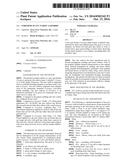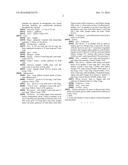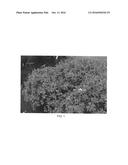Patent application title: Coreopsis plant named 'Ladybird'
Inventors:
Harini Korlipara (Canby, OR, US)
Harini Korlipara (Canby, OR, US)
Assignees:
Terra Nova Nurseries, Inc.
IPC8 Class: AA01H500FI
USPC Class:
PLT418000
Class name:
Publication date: 2016-10-13
Patent application number: 20160302342
Abstract:
A new and distinct Coreopsis plant named `Ladybird` characterized by
daisy-type inflorescences that grow to 4 cm in diameter, ray florets red
with gold tips, hardy to Zone 6, maybe lower, grass green foliage on
short stems, flowering for the whole summer, a very compact, mounding
habit, and excellent vigor.Claims:
1. A new and distinct Coreopsis plant as herein illustrated and
described.Description:
BOTANICAL DENOMINATION
[0001] Coreopsis hybrid
Variety designation
[0002] `Ladybird`
BACKGROUND OF THE INVENTION
[0003] The present invention relates to a new and distinct Coreopsis and given the cultivar name `Ladybird`. Coreopsis is in the family Asteraceae. This new cultivar originated from a controlled breeding program to produce hardy compact Coreopsis. The new cultivar originated from planned cross of two proprietary unnamed Coreopsis verticillata hybrid seedlings. The new cultivar of Coreopsis is an herbaceous perennial to be grown for landscape and container use in a sunny site.
[0004] Compared to the parent seedlings the new variety has a different flower color.
[0005] Compared to Coreopsis `Firefly`, U.S. Plant patent application No. 14/120,301, the new cultivar has flowers that are gold and red rather than yellow with a small red eye.
[0006] Compared to Coreopsis `Lightning Bug`, U.S. Plant Patent Application applied for, the new cultivar has ray florets that are red with gold tips rather than half and half gold and red.
[0007] Compared to Coreopsis `Red Satin`, U.S. Plant Patent Applied For, the new cultivar has ray florets that are an orange red color with gold tips rather than a maroon or blue red color. The new cultivar is more dense and compact, with more stems from the crown, and has smaller inflorescences.
SUMMARY OF THE INVENTION
[0008] The following traits have been repeatedly observed and are determined to be the unique characteristics of the new variety. These characteristics in combination distinguish Coreopsis `Ladybird` as a new and distinct cultivar:
[0009] 1. daisy-type inflorescences that grow to 4 cm in diameter,
[0010] 2. ray florets red with gold tips,
[0011] 3. hardy to USDA zone 6, maybe lower,
[0012] 4. grass green foliage on short stems,
[0013] 5. a very compact, mounding habit, and
[0014] 6. excellent vigor.
[0015] This new cultivar has been reproduced only by asexual propagation (cuttings and tissue culture). Each of the progeny exhibits identical characteristics to the original plant. Asexual propagation by cuttings and tissue culture using standard micropropagation techniques with terminal and lateral shoots, as done in Canby, Oreg., shows that the foregoing characteristics and distinctions come true to form and are established and transmitted through succeeding propagations. The present invention has not been evaluated under all possible environmental conditions. The phenotype may vary with variations in environment without a change in the genotype of the plant.
BRIEF DESCRIPTION OF THE DRAWING
[0016] FIG. 1 shows a group of nine-month-old Coreopsis `Ladybird` growing in the ground in the trial field in late July in Canby, Oreg.
DETAILED PLANT DESCRIPTION
[0017] The following is a detailed description of the new Coreopsis cultivar based on observations of nine-month-old specimens growing in the trial beds in full sun in Canby, Oreg. Canby is Zone 8 on the USDA Hardiness map. Temperatures range from a high of 95.degree. F. in August to 32.degree. F. in January. Normal rainfall in Canby is 42.8 inches per year. The color descriptions are all based on the Royal Horticultural Society Colour Chart, 2007, 5.sup.th edition, 2007.
[0018] Plant:
[0019] Type.--herbaceous perennial.
[0020] Hardiness.--USDA Zones 6 to 9.
[0021] Size.--45 cm wide and 25 cm tall to top of inflorescences.
[0022] Form.--mound.
[0023] Vigor.--excellent.
[0024] Roots.--fibrous, stems root easily from stem cuttings.
[0025] Stem:
[0026] Type.--ascending, well branched.
[0027] Size.--grows to 17 cm tall to where branches for flowering and 5 mm wide.
[0028] Number of stems from the crown.--about 8, more branching from stem bases.
[0029] Branching habit.--freely branching, an average of 8 lateral branches with secondary branches, branches are opposite in arrangement, new lateral flowering branches are continuously produced throughout the summer.
[0030] Internode length.--1.5 cm to 3.5 cm.
[0031] Surface.--glabrous.
[0032] Color.--Yellow Green 147C.
[0033] Leaf:
[0034] Type.--simple.
[0035] Shape.--pinnately 3-parted with thread-like segments, to linear on top leaves.
[0036] Arrangement.--opposite.
[0037] Size.--to 4.8 cm wide and 4.8 cm long, the linear segments can grow to 35 mm long and 3 mm wide.
[0038] Apex.--acute.
[0039] Margins.--entire.
[0040] Petiole.--2 mm to 9 mm long and 1 mm wide, Green N137A.
[0041] Surface texture.--mostly glabrous on both sides.
[0042] Venation.--pinnate, visible main vein the same color as the leaf on both sides.
[0043] Color.--topside Green N137A, bottom side Green 137B.
[0044] Inflorescence:
[0045] Type.--long stalked terminal heads of daisy type inflorescences.
[0046] Peduncle.--grows to 4.5 cm long, 1 mm wide, glabrous, Green 137B.
[0047] Size.--grows to 4 cm wide and 11 mm deep.
[0048] "Flower bud".--globular, 4 mm wide and 5 mm deep, Yellow Green 147B, glabrous.
[0049] Receptacle.--disc shaped, 3 mm wide and 1.2 mm deep, Yellow Green 145B.
[0050] Phyllaries.--in 2 series; upper series surround florets, campanulate, about 5 lobes in number, in an area 5 mm deep and spreading 4 wide mm wide, each lobe ovate, grow to 4 long and 2 mm wide, margin entire, tip acute, glabrous on both sides, both sides Yellow Green 148A on bottom 2/3 and Yellow Orange 22B on top 1/3; lower series at base of inflorescence, stellate, 5 to 7 in number, in an area 2 mm deep and spreading 6 mm wide, each lobes linear, 3 mm long and 1 mm wide, margin entire, tip acute, Green N137A.
[0051] Lastingness.--each inflorescence lasts about a week on the plant.
[0052] Florets:
[0053] Type.--composite.
[0054] Ray florets.--8 in number with no pistil or stamen, grows to 20 mm long, 6 mm wide, obovate, with the tip acute and top 1/3 sometimes irregularly notched, side margins entire, glabrous on both sides; topside closest to Red 47A with tip variously marked Yellow Orange 15C, bottom side Greyed Orange 161BA on top 2/3 and Greyed Red 178A on bottom 1/3
[0055] Disc.--rounded 7 mm wide and becoming 3 mm deep with maturity, Greyed Purple 187B.
[0056] Disc florets.--tubular, with stamen and pistil, about 24 in number, 8 mm long and 1 mm wide, tubular; corolla 4 mm long, 5 lobed, tube Yellow Orange 15D, lobes Greyed Purple 187B; pistil 1, 8 mm long, ovary 3 mm long, Greyed Yellow 161A, style 5 mm long, with extruding, 2-branched stigma, stigma and style Orange 26A; stamen 5, anthers 1.2 mm long, Greyed Brown N199B, pollen none.
[0057] Bloom period.--June to August and will rebloom if trimmed back in Canby, Oreg.
[0058] Fragrance.--none.
[0059] Seed.--none seen.
[0060] Fertility.--poor.
[0061] Disease and pests: No pests or diseases have been observed on plants grown under commercial conditions in Canby, Oreg.
User Contributions:
Comment about this patent or add new information about this topic:



